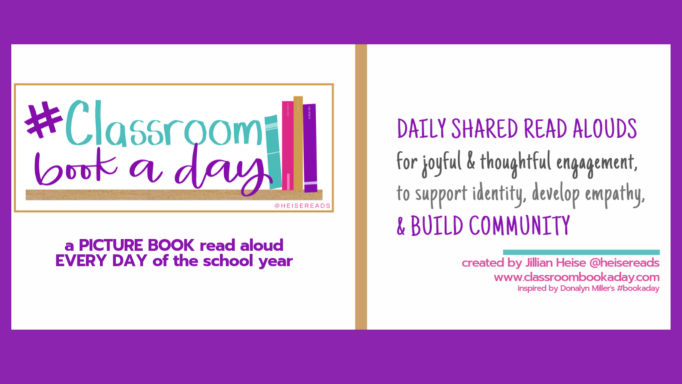

BLOGS > AUGUST 4, 2021
BY JILLIAN HEISE

One of my favorite types of picture books to use for #ClassroomBookADay often leaves some teachers wondering how they can be used for read-alouds.
Yes, I’m talking about the wordless picture book.
One of the benefits of daily picture book read-alouds with #ClassroomBookADay is an increased appreciation for art as well as deepening visual literacy skills. And there might be no better way to enhance these skills than sharing and discussing a wordless picture book. Yet, when I first wanted to share a wordless picture book as a read-aloud, I wasn’t sure how best to manage it in a way that would help students really see the book and understand the depth of thinking that can be found in a wordless picture book. Along with my book recommendations, I’m sharing some of the tips I’ve discovered and things I’ve learned along the way in how best to present wordless picture books as a read-aloud.
Logistics of a Wordless Read Aloud
The first step in reading aloud a wordless picture book is to: Prepare students for the fact that this book has no words. It means they will have to pay even more careful attention to the illustrations.
They need to be able to see the pictures. My base expectation for our #ClassroomBookADay time is that students can sit wherever and however they’d like as long as they aren’t bothering, blocking, or distracting anyone else and they can see the pictures. There is a reason they are called picture books – the pictures tell at least half of the story! But for a wordless picture book, they need a little more warning that they will completely miss the entire story if they can’t see the illustrations.
Share the book under a document camera to a projector in a classroom or via a screenshare in a virtual class. The teacher also needs to ensure there is enough time allotted for the read-aloud because a wordless picture book can often take twice as long to read.
Start with a picture walk first. Ask students to just take in each page and think in their own heads about what is happening in the story.
Do a reread where you can stop on each page spread and students can contribute to telling what they see happening on that page as part of the story, or something they notice/wonder.
Have students tell the story. It could be done in small groups or as write/pair/share instead of just on the spot, if preferred. When we get to the end, we can then discuss any different opinions or alternative interpretations of the story. We may also then look at the book summary online or on the jacket flap to see if our telling of the story aligns with what the author’s purpose may have been.
A Scaffolded Approach
When first sharing wordless picture books, I chose to group them during a whole week for #ClassroomBookADay read-alouds. My plan was to scaffold students’ understanding and ability to “read” a wordless book through the complexity of the stories I shared. Starting with a wordless picture book with a clear, straightforward plot works best – A Ball for Daisy or any of Molly Idle’s Flora and the animal (flamingo, penguin, peacocks) books are a good starting point. They are fun and entertaining with clear plots. I then choose wordless books with gradually more complex plots or fantasy elements working up to something like the Journey trilogy or Another.
The Justification
But what happens when someone sees you reading aloud a wordless picture book and questions whether it meets the complexity and skills you’re required to teach? Give them this list of benefits:
1. Supporting visual literacy skills for those gravitating to graphic novels
2. Understanding and identifying story elements
3. Deepening inferencing skills
4. Clarity with summarizing and analyzing illustrations for context and details
5. Providing evidence to support claims
It’s just a start but should make the point. There are strong reading skills that can be developed within books that contain no words. They have as much value in our classrooms, at any grade, as books with only words that contain no illustrations – those ones we often push kids into too quickly once they can decode, yet visual literacy skills are only becoming even more important to develop in a digital society. So, grab a stack of wordless picture books and see what your students come up with.
A Note About Interpreting Wordless Stories
When we focus on testing an author’s purpose in education, too often we lead students to think that there is only one right answer and they have to guess at what an adult says a book is about. But let’s look at what the author/illustrators themselves say about kids interpreting their wordless stories.
In Unspoken, Henry Cole ends his author’s note with, “Because I made only the pictures, I’m hoping you will write the words and make this story your own – filling in all that has been unspoken.”
And at the end of A Stone for Sascha, Aaron Becker notes the deeper questions he was considering when he dreamed up the story, and says, “My intention isn’t to answer any of these questions, but instead to encourage readers to discover their own path through the book projecting their experience onto the illustrations and discovering, within the openness of these wordless pages, their own epic story.”

See my list of book suggestions on Titlewave®.
Wordless picture books empower students to take ownership of their interpretations of books. They can focus on details in visual elements and learn that their own experiences that they bring into their inferences in a text matter. That their voices and their stories matter. And that is a vital lesson to share.

Read all of Jillian Heise's #ClassroomBookADay articles, and watch this webinar recording presented by Jillian Heise, Building Community: #ClassroomBookADay Read Alouds.

Jillian Heise
Jillian Heise, NBCT and MLIS, is currently a K-5 Library Media Teacher in southeastern Wisconsin. She previously taught Grades 7 and 8 ELA in the Milwaukee area for 11 years. Jillian is the founder of #classroombookaday and dedicated to supporting all student identities and lived experiences through access to inclusive literature. She brings her literacy expertise and knowledge of kidlit to her role as Chair of the USRA Children's Literature Committee. You can find Jillian online at Heise Reads & Recommends and @heisereads.
Classroom Libraries Part 1: Organizing & Designing Your Classroom Library
April 12, 2024
We all know that books are essential for learning, and as educators we buy them, collect them, receive them, but then what? We have some great and not-so-great books in our classrooms, and it’s hard to decide what goes into...
Read more
The Top 5 Strategies for Cost-Effective IT Management in K-12 Schools and Districts
April 9, 2024
Introduction IT management has become much more than just keeping the lights on in the computer lab. It's about creating an environment where technology enhances learning without breaking the bank. Let's dive into the top five strategies that will not only save you pennies but...
Read more
Enjoy free digital access to books releasing this summer!
April 8, 2024
Follett partnered with Penguin Young Readers Group and NetGalley* to provide digital access to upcoming fiction titles through August 27. Get early access to favorite topics – novels in verse, mystery, realistic fiction, friendship – then preorder the books you...
Read more
Future-Proofing Education: Why Cloud Hosting Is Key to Technological Advancement
April 8, 2024
In an era where technology evolves at lightning speed, the education sector cannot afford to lag. For K-12 school districts, maintaining a robust, scalable, and secure IT infrastructure is not just about keeping pace with current trends but ensuring they...
Read more
Spring into the new season with the most sought out titles!
March 25, 2024
Well-known librarian Shannon McClintock Miller has selected 13 elementary titles from Capstone Publishing as must-reads for your readers. Including fiction and nonfiction and a variety of genres, these books focus on interesting topics and subject matter that students want to...
Read more
March 25, 2024
Your K-5 students will love the latest installments in several wildly popular, acclaimed series coming out this spring. Check out these highly anticipated titles by powerhouse authors! Shop Now Always AnthonyBy Terri LibensonAvailable: May 7, 2024This eighth book in the New York...
Read more